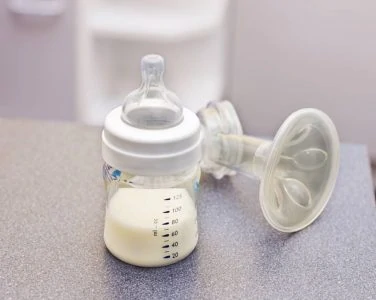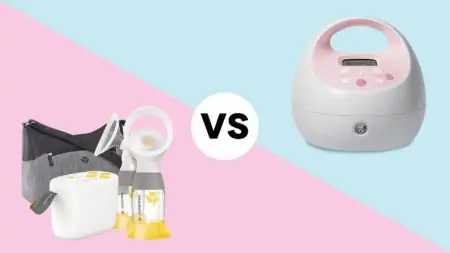When you committed to nursing or pumping your milk, you probably envisioned doing so in the privacy of your home or office. But sometimes there’s no private, convenient space to pump. So, what happens then?
How do you meet your need to pump when there’s no clear space to do so?
It turns out, it’s possible to pump in public — and even do so discreetly. We have many combined years of experience and have compiled the advice of other experienced moms to bring you this guide on how to pump in public, so you don’t have to worry about feeling uncomfortable while you pump.
Key Takeaways
- “Pumping in public” refers to any situation in which a mother is pumping breast milk outside of a private, guaranteed space.
- It is important to pump regularly to maintain milk supply, but if an individual is running late, they can delay their pumping session by a half hour to an hour.
- While all 50 states have provisions granting women the right to breastfeed in public, they do not explicitly provide protection for moms who are pumping. It is recommended to check state legislation for specific language in the legal code about pumping in public spaces.
- To pump in public, ask about available spaces, and bring special equipment such as a breast pump bag, nursing bras, and a nursing cover.
What Exactly Is “Pumping in Public?”
“Pumping in public” refers to any situation in which you’re pumping breast milk outside of your normal, guaranteed private space.
There are varying degrees of what constitutes “public.” Pumping in a semi-private situation means you are pumping in an enclosed space that others can still access.
Examples of semi-private spaces include:
- Nursing mothers’ rooms in public locales.
- A bathroom stall.
- Your car.
- A friend’s house.
Then there are times when you pump in a truly public place, such as out in the open with people present who may (or may not) be able to tell what you are doing.
Examples of public places include:
- Airplanes.
- Parks.
- Concert arenas.
- Public bathrooms (outside the semi-privacy of a stall).
If you prefer to be modest or feel self-conscious about pumping in public, it may be best to first attempt pumping in a semi-private location to gain confidence in your ability to pump discreetly in a public place.
Can’t Pumping Wait Until I’m Home?
If you’re running late to get home from an outing or back to the office after an appointment, delaying your pumping session by a half-hour to an hour is no big deal.
But if you are regularly on the go, erratic pumping times can seriously affect your milk production (source).
Take Note
Generally, your body will reduce production after 3—4 days of reduced demand. Once your milk flow is “established” (right around the 3-month mark), it’s much more difficult to increase your supply, so it’s a good idea to pump regularly and maintain your supply.
Is It Legal to Pump in Public?
While all 50 states have provisions granting women the right to breastfeed in public, they do not explicitly provide protection for moms who are pumping (1). It may be a good idea to check your state’s legislation for any specific language in their legal code about pumping in public spaces.
If no legal permission is given, you may want to ensure your nipples are effectively covered when you pump in public so as not to be cited under “public indecency” laws.
While any nursing or pumping mom understands there is nothing indecent about pumping milk for their baby, it’s better to be safe than sorry when there is no specific legal protection.
What You Need to Pump in Public
You may need some special equipment to pump in public. While not all of it may be absolutely required, they can certainly make the job easier. The good news is many of these items will make pumping in private more convenient too.
Some items to consider:
- Breast pump bag to keep everything organized.
- Nursing bras for convenience.
- A nursing cover.
How Do I Pump in Public?
1. Ask About Available Spaces
These days, many places have lactation rooms or are happy to make private arrangements for those who need them, but you’ll never know if you don’t ask! So, ask the front desk or another employee (a manager is probably best) if there is available space for nursing mothers.
You can even do an internet search to see if a nursing room is available close to you.
If there is, your problem is solved and you can pump as you normally would. If not, then get ready, it’s time to embark on your first public pumping adventure!
2. Wear Your Pumping Bra
If you’re going to be pumping in public, it’s best to put your pumping bra on at home and wear it for the day, if possible. If your hands-free bra has holes in the nipples without an enclosure, affix a breast pad in them to cover the nipple and provide you protection while you’re wearing the bra full-time.
If you don’t own a hands-free pumping bra, you can always convert yours. Cut small holes in the nipples of an old sports bra and affix breast pads inside to provide coverage and protection when you are wearing the bra. When you pump, remove the breast pads and slip the flanges through the holes.
If you find yourself needing to pump publicly without planning, or if you couldn’t wear your hands-free pumping bra all day, move your regular bra above your breasts, and put on your pumping bra while under your nursing cover.
Another alternative is to privately change into your pumping bra in the bathroom, even if you don’t intend to pump in there.
3. Choose the Ideal Pump for Your Lifestyle
Evaluate how frequently you’ll need to pump in public, and in which settings it’s most likely to occur. Choose your pump accordingly.
- A manual breast pump is silent and discreet. While it takes more physical effort than an electric pump and is not as efficient, it may be a good option for the mom who is embarrassed by the noise and attention an electric pump may draw, or the mom who does not expect to pump frequently.
- An electric pump with a battery compartment can be used anywhere without the need for a power source. This may be a good option if you expect to pump frequently and aren’t sure whether an electrical outlet will always be available.
- An electric pump paired with either a car adapter or a car power converter is a good option for those who need to pump in the car and don’t want the added expense of purchasing batteries for their pump.
If the pump comes with a car adapter accessory, it will plug directly into the car’s power outlet. If no adapter is available for your breast pump model, use a car power converter plugged into the power outlet. Your breast pump will then plug into the converter just like any other outlet.
4. Pre-Assemble the Parts
To make the process of pumping in public faster and more discreet, pre-assemble the pump parts and connect them to the collection bottles.
Place them in a gallon-sized zip-top bag to keep them sanitary.
Take Note
If you choose this method, don’t forget to pack the tops of your bottles! You’ll need them to store your milk after pumping.
5. Dress for Pumping Ease
Before you leave the house, make sure the shirt you have chosen will easily accommodate pumping. Wearing a nursing top usually makes it easy to access the breasts and nipples. If you don’t have an appropriate nursing top, consider button-down shirts or loose-fitting tops.
Avoid tight-fitting shirts that will restrict your movement and make access to your breasts and nipples difficult when it’s time to pump.
Definitely don’t choose a one-piece dress (which I once made the mistake of doing for a family wedding)!
Editor's Note:
Michelle Roth, BA, IBCLC6. Choose Your Cover
Bring something to provide plenty of coverage while you’re pumping that also allows you freedom of movement as you maneuver your pump into place without exposing your breasts. Some options include:
- A nursing cover.
- A large scarf.
- A baby blanket with two corners tied behind your neck.
7. Store Your Milk
After you have pumped, you will need to properly store your milk to preserve it until you’re home. To avoid spills, pump directly into breast milk storage bags, or store the milk in the bottles. Don’t try to transfer milk from baby bottles to bags when you’re out and about as you could risk spilling that liquid gold.
Keep your pumped milk in a cooler with ice packs to keep it cold until it can be refrigerated or frozen.
8. Clean Your Pump (if Necessary)
If your public pumping session is a one-time event that will not be repeated later in the day, there is no need to clean your pump parts. You can wash them in the convenience of your kitchen.
However, if you plan to pump again before you get the opportunity to wash them, consider bringing breast pump wipes for on-the-go cleaning. By simply wiping the flanges and other breast pump parts, everything will be clean and ready for your next on-the-go pumping session.
FAQs
The Bottom Line
While pumping in public sounds daunting, with a little preparation and the proper tools, it can be a breeze. It also helps to be confident and maintain a sense of humor on the rare occasion when things may not go as planned.
Choosing the proper pump and accessories for your lifestyle, along with a good, large nursing cover, makes it easier to pump discreetly — even if you don’t have the privacy of your own space.











